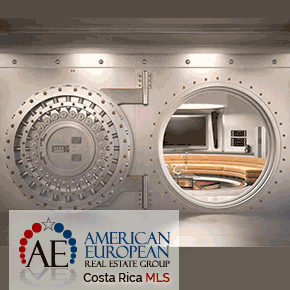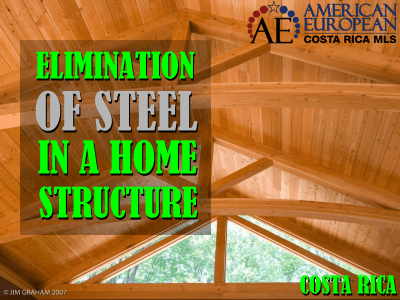 A Costa Rica home structure needs to be strong enough to withstand the earthquakes. Nonetheless, it is possible to eliminate steel and to use a green solution.
A Costa Rica home structure needs to be strong enough to withstand the earthquakes. Nonetheless, it is possible to eliminate steel and to use a green solution.
Laminated Wood or Bamboo beams for rafters and joists. These are a far superior solution for structural needs when building a Costa Rica home, that although be it rare in Costa Rica, is far more economical than steel, incredibly strong, much more stylish as well as a far better environmental solution. E.g. 1 cubic meter of wood consumes one ton of CO2 when growing. Versus steel that creates 1.8 tons of CO2. Hence the impact is almost triple.
Aside from that let’s look at the other benefits just bear with me as this requires a detailed explanation so as to understand just how this makes an excellent option for well-informed consumers.
GluLams
GluLams, as they are called, is a very common solution in North America for building an excellent home structure. Unfortunately, few use them in the Costa Rica construction industry. This is due to both the level of ignorance of the application of such as well as known availability. You do not just go grab them from the local ferreteria!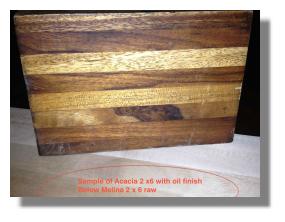
We have adopted these as our own preferred home structure material for our own homes in Costa Rica. We strongly recommend the use of this product to customers who seek superior solutions in both quality, price and as a green building method.
Green construction material
We are also just in the process of incorporating the use of bamboo in a home structure as well. Since there are huge tracks of bamboo inventory available which is substantially stronger than wood.
Bamboo grows much faster (4-5 years) and consumes as much as 4 times the CO2 as wood. Hence it makes an ideal green construction material since the carbon footprint of steel would be roughly 5.8 times higher. The harvest of bamboo culms does not affect the plantation at all since we selectively harvest only the mature. We leave behind all the immature culms for another day. Also, the root structure can continue producing bamboo crops for up to 120 years.
This means there is no environmental destruction in the harvesting process at all. Plus there is no erosion to precious soil structures. Erosion can occur and be very critical in flood-prone areas and mountainsides. Another advantage is that we get a beam substantially stronger than both steel and wood.
Suitable materials
Available materials suitable to make GluLams are
- Bamboo
- Teak
- Cedro
All three have the common critical characteristic of being termite safe materials that are not suitable lunch material for this army of pesky enemies.
Comparing GluLams to Steel
For those who would otherwise be considering steel for a home structure as an example, here is a simple comparison:
1 meter of 2″ x 6″ costs $8.50 – $10.00 depending on species versus at least requiring a doubling of purlins would be required to support the same load would cost $8.33.
Pound for pound laminated wood is stronger than steel. Also, take note the superior longevity if you are building at the beach. There is the oxidation factor on anything metal versus wood in any beach areas of Costa Rica. This is impervious to air born salt.
Plus, ugly purlin is always hidden away. Any wood home structure can be accented to add 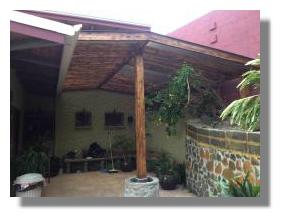 beauty in your exposed vaulted roof structure.
beauty in your exposed vaulted roof structure.
Go to our renovation page and you can see an example of a Pagoda roof we built in Santa Ana to cover an open terrace. Win, the client, loves laminated wood. We find with our clients that this is always a major concern, hence the much-preferred method.
There are two issues at hand here:
- One is responsible inventory management
- The other is strength and quality of the final product.
Comparing GluLams to a solid single piece of wood
First off dimensional hardwoods necessary for a home structure are getting harder and harder to locate. Very large trees have to produce usable hardwood. To cut good 2″ x 6″ (the most common size), it takes a tree trunk diameter of 16″ to 20″. We are talking about old trees (25-120 years under ideal conditions). Those trees are disappearing quickly, so actually finding it can be difficult. This kind of wood does not exist in young plantations.
That is drastically different if compared to the use of much younger (10-year-old) plantation grown trees/bamboo (5-year-old). Then, we only need 1 1/2″ x 3/4″ pieces to make up the lamination stock. Therefore, the raw material is muuuch cheaper with a never-ending inventory available.
As a result of global demand prices for premium wood for a home structure just keeps going up. This is due to this scarcity. Therefore, the wood from older trees costs much more, since you are basically purchasing time. It just simply is not responsible forestry management nor economical to take mature hardwoods to use for dimensional lumber. In fact, it is basically loco.
Quality material
The second issue is solid wood. No matter how old, it is just is not nearly as strong as a GluLam is. In fact, it is common to be able to reduce the beam size by 40% when laminated. Therefore, we consume way less wood to do the same job.
The other big problem is very few sawyers have kilns to properly dry the much thicker woods to make stable dimensional lumber. So it typically shows up on the job site soggy wet. No one is willing to wait the 3 years it will take to properly air dry it.
The inevitable result is this. There ARE GOING TO BE a number of pieces that are going to come curved or 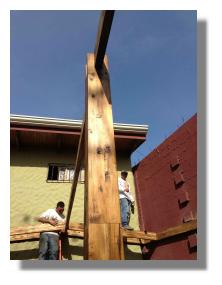 twisted or crowned after they are installed. This can create big problems in the home structure they are part of. Even with kiln dried materials used in Canada, the whole industry has gone away from solid floor joists in favor of laminated, engineered TJI or web trusses that never do this. So there are no warranty problems for the builder or owner.
twisted or crowned after they are installed. This can create big problems in the home structure they are part of. Even with kiln dried materials used in Canada, the whole industry has gone away from solid floor joists in favor of laminated, engineered TJI or web trusses that never do this. So there are no warranty problems for the builder or owner.
Also, there is reduced timber consumption. A laminated beam comes to the job site perfectly straight. Six months later it will still be and 66 years later it will still be so.
Hence it is much easier for the builder to use and muuuuch safer for the owner. Also, solid materials will always have cracks showing up over time as they dry out. The bigger the dimension the worse it is, versus laminated which will never develop cracks.
Comparing GluLams to concrete floors
For second story floors, there is really no option. A concrete reinforced floor costs $85 to $110 per square meter to construct. And it adds a minimum of two weeks to build out time for a 100 m2 floor. So a lot of money and time spent.
A wood a home structure will come in at roughly half price and be built 5 to 6 times faster. After the fact wood floors have the desired amount of spring in them. This reduces stress on feet and knees as we walk on them. And, it is considerably quieter with far less noise transfer.
First story
This is very important even on first story floors where the owners want a more forgiving floor to walk upon. Many may choose to cover such structures in mature Tico hardwoods. Then they can enjoy their beauty for years to come. This makes for a much smarter use of mature hardwoods than for dimensional lumber.
On sloped property
On sloped lots, wood is easier and often cheaper to build out a support home structure. Trying to level off a mountainside with sloping building sites is much more expensive. There are much less dirt movement and less future water erosion problems.
Posts of wood or concrete columns can much easier be built to accommodate such a situation than either cutting into a mountain or building up with fill to support concrete slabs. This also drastically reduces the need for use of concrete. You will also reduce the horrible environmental impact.
In conclusion, the use of GluLams for a home structure is a real win/win/win situation. It offers a better price, better quality, more comfortable home utilizing far superior green building principles.
The Authors
Trevor Chilton and Michael Pawluk arrived in Costa Rica over 12 years ago. They have been business  partners most of that time combining their experience in excess of 65 years of Canadian architectural and construction experience together. Trevor and Michael make a unique team to provide consultancy as well as cutting-edge building solutions to clients all over Costa Rica. During their travels, they had experienced many low-quality standards provided by other professionals. The use of poor materials and inefficient construction methods that have all too often lead to a serious nightmare for the affected Costa Rica real estate owners.
partners most of that time combining their experience in excess of 65 years of Canadian architectural and construction experience together. Trevor and Michael make a unique team to provide consultancy as well as cutting-edge building solutions to clients all over Costa Rica. During their travels, they had experienced many low-quality standards provided by other professionals. The use of poor materials and inefficient construction methods that have all too often lead to a serious nightmare for the affected Costa Rica real estate owners.
Over the past year and a half, they started writing an e-book about those same experiences in order to give the layman and consumer a place to go to better understand what it takes to build or buy existing homes  successfully in the tropics. What are the most common errors in construction that so often come back to haunt an owner? Throughout the book, particular attention is paid to building energy efficient homes using green building methods and materials.
successfully in the tropics. What are the most common errors in construction that so often come back to haunt an owner? Throughout the book, particular attention is paid to building energy efficient homes using green building methods and materials.
Fixing problems?
All of the predictable problems can be avoided during construction. If you only know what to look for or how to retrofit old problems. There has been no place to go to be so forewarned or simply informed until now. Not to dwell on the negative, this e-book also shows the best practices and materials. You will find over 100 pages of know-how shared and more than 160 photos and drawings to demonstrate the layman how and what should happen under better than average conditions.
The included post today is just one example of the ever-expanding knowledge base provided for the readers of The Easy Times at no cost.
Feel free to leave your comments on this blog. If you like this article, please feel free to share it on your social media.
If you like this blog, connect with me on Google+ or subscribe to our newsletter by clicking the banner below.
While we’re at it, I DO want to remind our readers that we appreciate any referrals you can send us. Finally, please remember the American-European real estate Group’s agents when you refer a real estate agent. Because we DO appreciate your business.


















